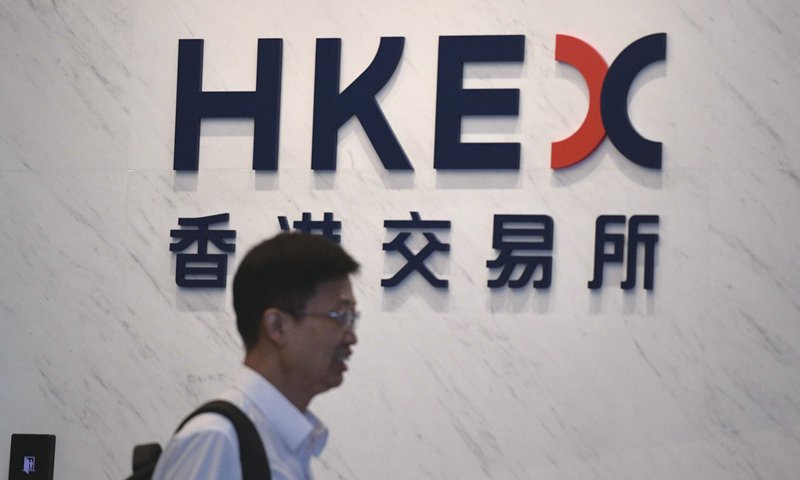Move to boost city’s financial sector, yuan’s global profile: experts
The Hong Kong Exchanges and Clearing Ltd (HKEX) officially launched the much-anticipated Hong Kong dollar-yuan dual counter model on Monday, in a move that will support Hong Kong’s role as an international financial center by injecting liquidity and vitality to its stock market.
The move will also boost the yuan’s internationalization with the development of more offshore yuan investment channels, officials and analysts said on Monday.
Hong Kong Special Administrative Region (HKSAR) Financial Secretary Paul Chan Mo-po inaugurated the counter, alongside HKEX chairwoman Laura May-Lung Cha and CEO Nicolas Aguzin.
The move to allow Hong Kong stocks to be traded in both the Hong Kong dollar and the yuan is “another significant milestone for our stock market,” Chan said. “It is clear that the internationalization of the yuan will only accelerate, particularly amid a fast-changing global geopolitical environment unseen in a century. Seeking diversification for greater security is on everyone’s agenda.”
Chan noted that “Hong Kong will play a pivotal role in this great process of change, and we are keen to grasp the opportunities ahead. We have long been the offshore yuan hub, no matter in terms of liquidity, trade settlement or product variety.”
As the program launched on Monday, 24 companies, including Tencent Holdings, Geely Automobile Holdings, Xiaomi Corp and Alibaba Group Holding, started offering yuan counters.
According to reports, these companies’ combined market capitalization hit HK$12 trillion ($1.54 trillion), which represents 35 percent of Hong Kong’s total share market. Those shares account for 40 percent of total turnover.
Under the dual counter model, investors will be able to interchange securities listed in both the Hong Kong dollar and yuan counters. Securities under the two counters are of the same class and holdings of securities in the two counters can be transferred without a change of beneficial ownership.
“The latest move, along with the connect programs between the Chinese mainland and Hong Kong, will play a positive role in boosting the development of Hong Kong’s financial market as well as the yuan’s internationalization,” Zhao Qingming, a Beijing-based veteran financial expert, told the Global Times on Monday.
By enriching the offering of yuan products for international investors in the world’s largest offshore yuan market, the new model will contribute to the development of China’s foreign trade and the yuan’s internationalization, according to Zhao.
He noted that the dual counter model will help reduce foreign exchange risks for investors, while yuan-denominated pricing could better reflect a mainland company’s fundamentals and valuation.
Bank of China Hong Kong (Holdings), China International Capital Corp Hong Kong Securities and CLSA are among the first batch of dual counter market makers. CLSA said that it will fully commit to the development of this model, further contribute to the internationalization of the yuan, and continuously enhance Hong Kong’s status as the world’s leading offshore yuan hub, according to a press release.
Along with the elevation of the yuan’s international roles, the supply of the yuan in offshore markets may increase remarkably and drive up dual counter trading, Dong Shaopeng, a senior research fellow at the Chongyang Institute for Financial Studies at the Renmin University of China, told the Global Times.
As an international financial center where Chinese mainland companies cluster, and the world’s largest offshore yuan hub, Hong Kong’s advantages as an offshore yuan market are obvious.
Official data showed that yuan deposits in Hong Kong totaled nearly 1 trillion yuan ($140 billion) as of the end of 2022, and about 75 percent of global offshore yuan settlements are handled in Hong Kong.
Along with market expansion, rich product supply and diversified investors, the liquidity and marketization of offshore yuan in Hong Kong will improve and boost high-level, two-way opening-up, Dong said.
Since the Shanghai-Hong Kong Stock Connect was officially launched in 2014, the connect program and integrated development between the HKSAR and the mainland has yielded remarkable results, with the Northbound Trading of Swap Connect launched in May.
HKSAR Chief Executive John Lee Ka-chiu said on June 9 that the regional government will continue to join hands with the mainland to expand and optimize connect programs, including adding yuan counters in mainland-HKSAR stock connects, so as to provide more risk-management tools for overseas investors and help rejuvenate Hong Kong’s capital market.
“As a new trading model, yuan-denominated trading may not account for a large proportion in the Hong Kong stock market in the initial stage, but it will build a solid foundation for the trading of yuan assets in Hong Kong by accumulating experience,” Zhao said.
With the dual counter model as a start, the yuan’s use in the Hong Kong financial market may be expanded to the trading of bonds and derivatives as well as yuan financing, he said.
(Global Times)




